1. Introduction:
The world of beef can be a fascinating realm where taste, texture, and prestige intersect. From backyard barbecues to Michelin-starred restaurants, beef cuts are a cornerstone of many culinary experiences.
However, within this realm, some cuts stand out for their exquisite flavour and tenderness and their eye-watering price tags. In this blog, we will explore the mystery behind the most expensive cut of beef.
2. Understanding Beef Grading and Quality:
Beef grading and quality assessment are crucial in determining the value and desirability of various beef cuts. Grading systems provide consumers and producers with a standardized way to evaluate beef’s characteristics, including marbling, tenderness, and flavour.
One of the most widely recognized grading systems is the USDA (United States Department of Agriculture) beef grading system, which categorizes beef into several grades based on specific criteria.
Within the USDA grading system, beef is classified into three main categories: Prime, Choice, and Select.
- Prime-grade beef represents the highest level of quality. It is characterized by abundant marbling, contributing to its tenderness, juiciness, and rich flavour profile.
- Choice-grade beef exhibits less marbling than Prime and is more widely available.
- Select-grade beef is generally leaner and less tender compared to Prime and Choice.
Other grading standards exist worldwide in addition to the USDA grading system. For example, Wagyu, which is highly revered for its beef quality, is graded on marbling, colour, texture, and firmness in Japan.
This meticulous grading process ensures that only the highest-grade Japanese Wagyu steak, such as Kobe and Matsusaka beef, receives the prestigious A5 grade, which denotes exceptional marbling and overall quality.
Beyond grading, several factors influence the quality of beef. These include the breed of cattle, their diet and feeding regimen, and the ageing process. Moreover, cattle raised on pasture and finished on a grain-based diet often yield beef with a well-balanced flavor profile and desirable marbling.
The ageing process also plays a crucial role in enhancing the flavour and tenderness of beef. Dry ageing results in a more tender and flavorful product, while wet ageing helps retain moisture and can contribute to a milder flavour profile.
Read More: What are the Top 5 Most Tender Steaks?
3. The Top 5 Most Expensive Cut of Beef:
While the prices of meat can fluctuate based on factors like region, demand and availability, some stands out as the most expensive of beef due to their exceptional quality and desirability. Here are the top 5 most expensive cuts of beef:
a. Wagyu Ribeye:
Renowned for its intense marbling and unparalleled tenderness, Wagyu beef ribeye is one of the most coveted and expensive beef cuts globally. Originating from Wagyu cattle breeds like Kobe, Matsusaka, and Omi in Japan, it boasts exquisite flavour and a melt-in-your-mouth texture, commanding top prices in luxury markets worldwide.
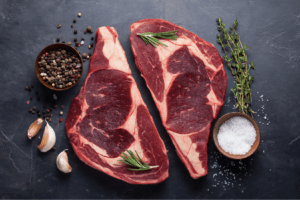
b. Kobe Beef Tenderloin (Filet Mignon):
Hailing from the Tajima strain of Wagyu cattle raised in Japan’s Hyogo Prefecture, Kobe beef tenderloin, also known as filet mignon, is celebrated for its unmatched tenderness and buttery flavour.
Raised under strict regulations and pampered with a diet of high-quality feed and sake, Kobe beef tenderloin commands premium prices due to its rarity and exceptional quality.
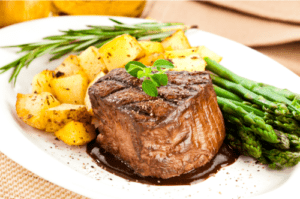
c. Matsusaka Beef Striploin (New York Strip):
Matsusaka beef, another prized Wagyu variety from Japan, is revered for its sumptuous marbling and rich, beefy flavour. The striploin cut, known as the New York strip in other regions, showcases Matsusaka beef’s exquisite quality, boasting a firm texture and robust taste that captivates discerning palates.
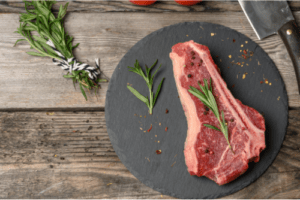
d. Dry-Aged Prime Ribeye:
Ribeye represents a pinnacle of beef indulgence, offering a marriage of intense flavour and sublime tenderness. Dry-aged for weeks in controlled environments, prime-cut ribeye steak develops complex umami notes and a buttery texture that elevates it to premium status. This will make it a favourite among steak fans willing to pay top dollar for culinary excellence.
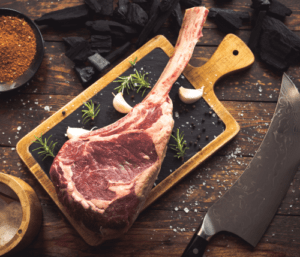
e. Chateaubriand:
Named after the French diplomat and gourmet François-René de Chateaubriand, the Chateaubriand cut is a thick centre-cut filet mignon taken from the tenderloin of the beef.
Prized for its tenderness and delicate flavour, Chateaubriand is often a luxurious centrepiece for special occasions and fine dining experiences, commanding premium prices in upscale restaurants and markets.
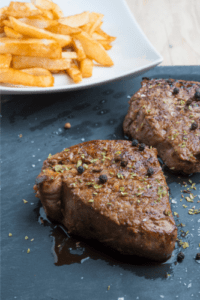
Read More: How Much Protein is in a Pound of Steak?
4. Factors Affecting Beef Prices:
Several factors influence beef prices, including global economic trends and local supply and demand. Fluctuations in consumer preferences, dietary trends, and population growth directly impact the demand for beef products.
Meanwhile, the availability of these premium cuts can fluctuate due to factors. These includes weather conditions, outbreaks of disease, and fluctuations in feed costs. Production costs, including expenses related to feed, labour, and transportation, also play a significant role in determining beef prices.
Additionally, government policies and regulations, exchange rates, and currency fluctuations can affect beef exports and imports, contributing to pricing dynamics within the industry.
Read More: What is the Difference Between White and Dark meat? Which is Better
5. Final Thoughts:
The world of beef offers a tempting array of options, each boasting unique, tender, juicy, and flavorful tastes. From the exquisite marbling of Japanese Wagyu beef to the melt-in-your-mouth perfection of Kobe beef tenderloin, exploring the most expensive cut of beef unveils a journey through craftsmanship, tradition, and culinary artistry.
